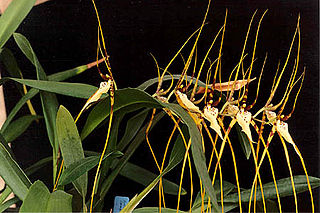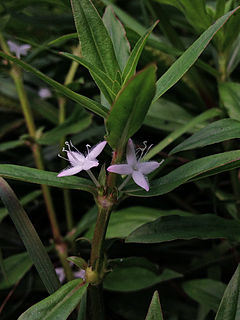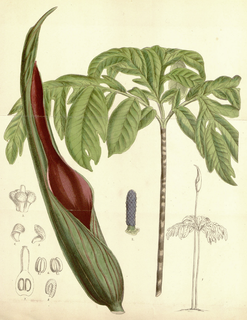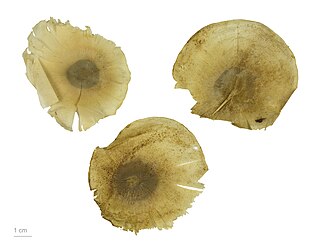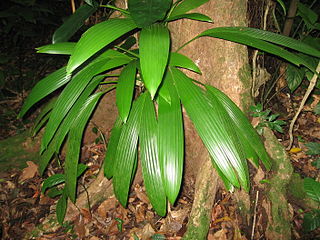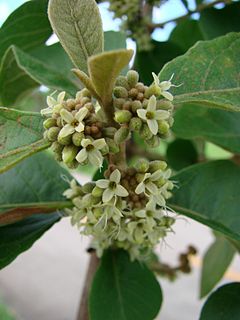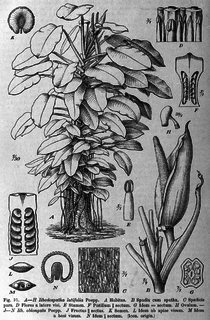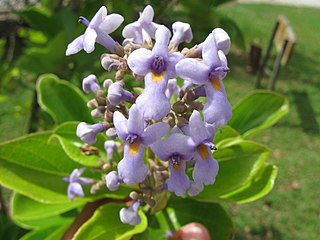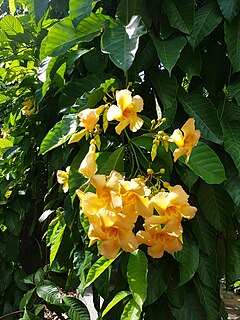| Schlegelia | |
|---|---|
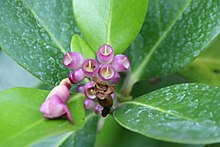 | |
| Schlegelia parasitica flowers | |
| Scientific classification | |
| Kingdom: | Plantae |
| Clade: | Angiosperms |
| Clade: | Eudicots |
| Clade: | Asterids |
| Order: | Lamiales |
| Family: | Schlegeliaceae |
| Genus: | Schlegelia Miq. |
Schlegelia is a group of plants described as a genus in 1844. [1] [2]
Schlegelia is native to tropical parts of the Western Hemisphere from southern Mexico and the West Indies to southern Brazil. [3]

The Western Hemisphere is a geographical term for the half of Earth which lies west of the prime meridian and east of the antimeridian. The other half is called the Eastern Hemisphere.

Mexico, officially the United Mexican States, is a country in the southern portion of North America. It is bordered to the north by the United States; to the south and west by the Pacific Ocean; to the southeast by Guatemala, Belize, and the Caribbean Sea; and to the east by the Gulf of Mexico. Covering almost 2,000,000 square kilometres (770,000 sq mi), the nation is the fifth largest country in the Americas by total area and the 13th largest independent state in the world. With an estimated population of over 120 million people, the country is the tenth most populous state and the most populous Spanish-speaking state in the world, while being the second most populous nation in Latin America after Brazil. Mexico is a federation comprising 31 states and Mexico City, a special federal entity that is also the capital city and its most populous city. Other metropolises in the state include Guadalajara, Monterrey, Puebla, Toluca, Tijuana and León.

The West Indies is a region of the North Atlantic Ocean and the Caribbean that includes the island countries and surrounding waters of three major archipelagos: the Greater Antilles, the Lesser Antilles, and the Lucayan Archipelago.
- Species [3]
- Schlegelia aurea - Brazil (Amazonas)
- Schlegelia axillaris - Jamaica, Lesser Antilles
- Schlegelia brachyantha - Greater Antilles, Venezuela, Costa Rica, Panama
- Schlegelia cauliflora - Loreto
- Schlegelia chocoensis - Colombia, Ecuador
- Schlegelia darienensis - Colombia, Ecuador
- Schlegelia dressleri - Panama, Ecuador
- Schlegelia fastigiata - Colombia, Ecuador, Central America
- Schlegelia fuscata - Colombia, Ecuador, Central America, French Guiana
- Schlegelia hirsuta - Colombia
- Schlegelia macrocarpa - Guatemala
- Schlegelia macrophylla - French Guiana, Peru
- Schlegelia monachinoi - Colombia, Ecuador, Venezuela
- Schlegelia nicaraguensis - Central America, Veracruz
- Schlegelia pandurata - Colombia, Ecuador
- Schlegelia paraensis - French Guiana, Suriname, Pará
- Schlegelia parasitica - Jamaica
- Schlegelia parviflora - from Belize to S Brazil
- Schlegelia roseiflora - French Guiana, Peru
- Schlegelia scandens - northern South America
- Schlegelia spruceana - Guyana, Venezuela, N Brazil
- Schlegelia sulphurea - Colombia, Ecuador
- Schlegelia violacea - northern South America
